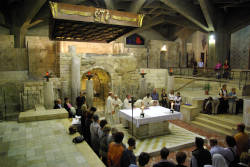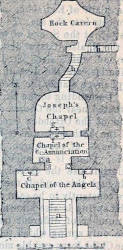Church of the Annunciation
Basilica of the Annunciation
Useful Information
| Location: |
Al-Bishara Street 12, Nazareth.
(32.702222, 35.297778) |
| Open: |
Cave:
All year daily 5:45–21. Upper Basilica: All year daily 8–18. Museum: Summer daily 8–12, 14-18. Winter daily 8–12, 14-18. [2021] |
| Fee: |
free, donations welcome. [2021] |
| Classification: |
 cave churches cave churches
|
| Light: |
 Electric Light Electric Light
|
| Dimension: | |
| Guided tours: | self guided |
| Photography: | allowed |
| Accessibility: | no |
| Bibliography: |
Brother Benedict Vlaminck O.F.M. (1900):
A Report of the Recent Excavations and Explorations conducted at the Sanctuary of Nazareth,
Washigton, Commissariat of the Holy Land, 1900.
Prosper Viaud (1910): Nazareth et ses deux églises de l’Annonciation et de Saint-Joseph, Picard. Bellarmino Bagatti (1969): Excavations in Nazareth: From the beginning till the XII century, Franciscan Printing Press, 1969 - 326 pp. Bellarmino Bagatti (1969): Excavations in Nazareth: From the 12th century until today, Franciscan Printing Press, 1969 - 206 pp. |
| Address: |
Church of the Annunciation, Annunciation Monastery, P.O.B. 23, 16100 Nazareth, Tel: +972-46-560001.
E-mail: |
| As far as we know this information was accurate when it was published (see years in brackets), but may have changed since then. Please check rates and details directly with the companies in question if you need more recent info. |
|
History
| 427 | Byzantine church built. |
| 12th century | Basilica built by Tancred, the first Prince of the Galilee. |
| 1889 | investigations by Prosper Viaud. |
| 1263 | Mameluk leader Sultan Baybars destroys the great cathedral. |
| 1730 | Franciscan Church built. |
| 1877 | Franciscan Church extended. |
| 1900 | first excavatiosn by Brother Benedict Vlaminck published. |
| 1907-1909 | further investigations by Prosper Viaud. |
| MAR-1955 | Franciscan Church, the old convent, and schools were demolished. |
| 1950-60 | remains of the Byzantine church excavated. |
| 1969 | Basilica rebuilt and consecrated. |
| 1982 | Brother Benedict Vlaminck discovers a second grotto with frescoes. |
Description


The Basilica of the Annunciation is the largest of all the churches in the modern town of Nazareth. The Annunciation is the announcement brought to Mary by the angel Gabriel that she was to become the mother of the Messiah. It was erected over the sacred Grotto of the Annunciation which was according to tradition a part of the house of the family of Mary and the place where she received the announcement. At first a church-synagogue used by the early Jewish-Christians was errected on this place. Later a Byzantine basilica was erected and this remained in use until the 12th century. Then the crusaders under Tancred, the first Prince of the Galilee, built a huge new basilica. It was destroyed by Mameluk leader Sultan Baybars in 1263.
Legend tells that when the Crusaders lost Nazareth to the Muslims in the 13th century, angels came down from heaven, picked up the church and transported it to the Italian village of Loretto near Ancona. Also known as “Nazareth de Italia” the local church there is called “Santa Casa”- the Holy House.
There are actually 18 churches of the Annunciation in Nazareth. That’s not really hard to understand, the Bible does not mention the exact places and speculations are futile. So they were replaced by legends. The Catholic Basilica of the Annunciation is located on top of the cave which was Mary’s home.
In the sixth month the angel Gabriel was sent by God to a town in Galilee called Nazareth, to a virgin betrothed to a man whose name was Joseph, of the house of David; and the virgin’s name was Mary.
And he came to her and said, "Hail, O favoured one, the Lord is with you!": But she was greatly troubled at the saying, and considered in her mind what sort of greeting this might be.
And the angel said to her, "Do not be afraid, Mary, for you have found favor with God. And behold, you will conceive in your womb and bear a son, and you shall call his name Jesus.
He will be great, and be called the Son of the Most High; and the Lord God will give to him the throne of his father David, And he will reign over the house of Jacob forever;
And of his kingdom there will be no end."
And Mary said to the angel, "How shall this be, since I have no husband?"
And the angel said to her, "The Holy Spirit will come upon you, and the power of the Most High will overshadow you; therefore the child to be born will be called holy, the Son of God.
Book of Luke (Luke 1:27-35)
The underground structures of the cave are often called crypt, but actually they are the former cave house of Mary (and Joseph obviously). It seems cave houses were quite popular in Nazareth at this time. The structures were examined since the late 19th century by Brother Benedict Vlaminck an by Prosper Viaud. But in 1955 the church was demolished and rebuilt and in 1969 the new church was consecrated. But after the old church was demolished there was the chance to excavate the whole area without restrictions. More than 120 local workers were digging on a daily basis, closely watched by father Bellarmino Bagatti and father Gaetano Pierri. The cleared an area of around 90 m x 60 m. Remains of the crusader and Byzantine churches and the ancient village were discovered. The excavation of the village can be visited today in the archaeological area at the side of the Basilica. A system of natural and artificial caves were an integral part of the dwellings. Different storage bins for grain as well as cisterns for water were found. The site was used from the iron age up until modern day.
 Search DuckDuckGo for "Church of the Annunciation"
Search DuckDuckGo for "Church of the Annunciation" Google Earth Placemark
Google Earth Placemark Basilica of the Annunciation - Wikipedia (visited: 27-MAR-2021)
Basilica of the Annunciation - Wikipedia (visited: 27-MAR-2021) NAZARETH The Basilica of the Annunciation (visited: 28-MAR-2021)
NAZARETH The Basilica of the Annunciation (visited: 28-MAR-2021) Index
Index Topics
Topics Hierarchical
Hierarchical Countries
Countries Maps
Maps